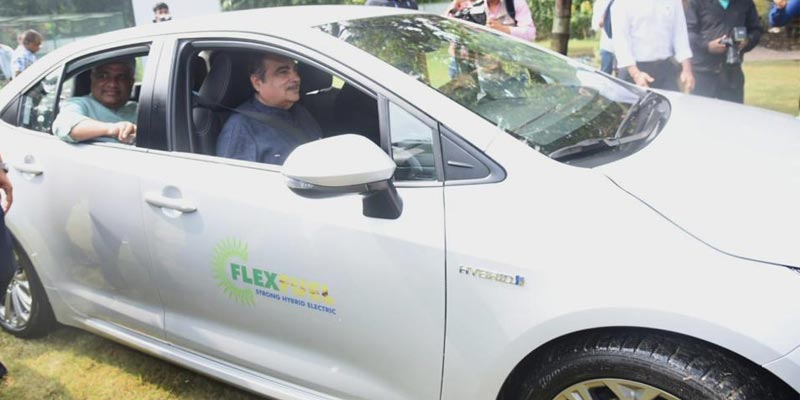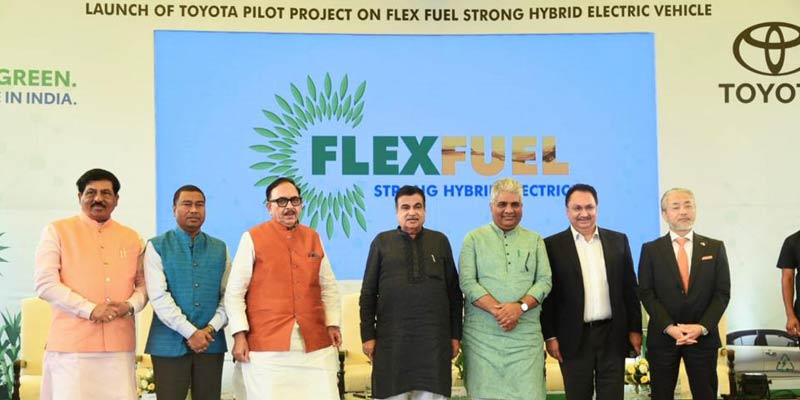- India
- Oct 12
Explainer / Flex Fuel-Strong Hybrid Electric Vehicle (FFV-SHEV)
• Union Minister Nitin Gadkari launched Japanese car maker Toyota’s first-of-its-kind pilot project on Flex Fuel-Strong Hybrid Electric Vehicle (FFV-SHEV) that can run on 100 per cent ethanol as well as 20-100 per cent blended ethanol and electric power.
• During the launch, the Toyota Corolla Altis FFV-SHEV, which has been imported from Toyota Brazil for the pilot project, was unveiled.
• The government is working to encourage the use of green and alternative fuels. Last year, the government issued an advisory to carmakers to introduce flexible-fuel engines in vehicles.
• In March this year, Gadkari had launched India’s first green hydrogen-based advanced Fuel Cell Electric Vehicle (FCEV), Toyota Mirai, and had said this is the first-of-its-kind project in India that aims to create an ecosystem for such vehicles in the country.
What are flex fuel engines?
• A flexible fuel vehicle (FFV), as its name implies, has the flexibility of running on more than one type of fuel.
• FFVs have an internal combustion engine and are capable of operating on gasoline and any blend of gasoline and ethanol/methanol.
• Like conventional gasoline vehicles, FFVs have a single fuel tank, fuel system, and engine.
• FFVs provide an opportunity of greater substitution of petrol by ethanol as it is capable of using any of the higher blends of ethanol mix from 20 per cent up to 100 per cent.
• Some special ethanol-compatible components are required to compensate for the different chemical properties and energy content in ethanol, such as modifications to the fuel pump and fuel injection system.
• While fuel economy (mileage) is generally lower with increased levels of ethanol (due to the lower energy content in ethanol as compared to gasoline and because the engines are optimized for gasoline), many FFVs have improved acceleration performance when operating on higher ethanol blends.
• In the West, FFVs have been produced since the 1990s, and more than one hundred models are available.
What is FFV-SHEV?
• Globally, many countries like Brazil have hugely benefited from large scale introduction of FFVs. In Brazil, an innovative Flex Fuel-Strong Hybrid Electric Vehicle (FFV-SHEV) technology has been introduced by Toyota Brazil, which has the lowest Well-to-Wheel (W2W) carbon emissions for any technology in the country.
• An FFV–SHEV has a flex fuel engine and an electric powertrain, thus providing dual benefit of higher ethanol use and greater fuel efficiency, as it can run for significant time periods on its EV mode, wherein the engine is shut off.
• The FFV-SHEV has much higher economic multiplier benefits, as it can hasten local manufacturing of electric and flex-fuel powertrain parts, thus providing a disruption free & low risk industry and energy transition.
• As this technology provides the opportunity to benefit from both electrification and bio-fuel energy pathways, it enables a faster reduction of fossil fuel consumption, CO2 emissions, as well as boosting the agrarian economy.
Challenges for adoption of FFVs:
• From the customer perspective, flex fuel vehicles may not seem feasible in India, since the cost of ownership and running cost are going to be very high compared with regular vehicles.
• FFVs could be more expensive than regular vehicles due to the upgradation of materials, engine parts and fuel system. Further, running cost (due to lower fuel efficiency) will be higher by more than 30 per cent.
• Unless the fuel cost of FFVs at retail outlets is made cheaper, customers may not prefer these vehicles. Customer acceptance will be the big challenge in this case.
• Development effort of a flex fuel vehicle is much higher than regular vehicles considering that the control systems have to be calibrated with multiple blends to derive optimum efficiency and meet emission regulations. Investing in development of such vehicles is not viable if the fuel is not available across the country.
Manorama Yearbook app is now available on Google Play Store and iOS App Store


